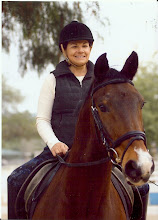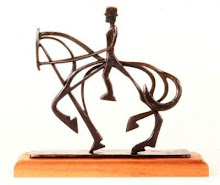Clinic with Debbie McDonald
Had a wonderful opportunity to watch a professional dressage rider explain the subtleties of riding dressage. Also, meet some of the other para riders from around the country. Couldn't work the details of bring a horse but..... next time.
Attending a workshop tomorrow about the Balimo Method. This is a concept that improves balance, feeling and timing while riding a horse through unmounted exercises. I am determined!
Video
Saturday, March 20, 2010
Monday, March 15, 2010
2010 Del Mar Show
by Kathy Beal
Show manager Kim Keenan Stordahl proves her visionary capabilities once again as the sixth annual Dressage Affaire, CDI, opened Friday, March 12, with its traditional CDI3*YJ along with its first annual CPEDI3*(Para Equestrian CDI). This means that the 2010 show offers CDI classes for para-equestrians alongside those offered to able-bodied equestrians. Keenan was excited that nine para-equestrians had entered the show. The Para classes had international Para Judge Hanneke Gerritsen (NED) and th weekend also includead a para clinic with Debbie McDonald. Many of these para riders perform on borrowed horses, and many of their horses, as well as the other CDI riders’ horses must travel considerable distance to compete. Unfortunately, some horses did not pass the jog. This is a great disappointment to any competitor, but as Para Judge Hanneke Gerritsen stated “It is of the utmost importance that we compete on healthy horses. Unfortunately, some horses did not pass the jog. One of the para-competitor’s horses had traveled 36 hours to compete and was unsound when jogged out. This made the rider horseless, but because para-riders can qualify on various horses, one rider did borrow a horse. "I was so proud of Jonathan Wentz for going forward and borrowing a horse that he had never ridden and competing anyway." Hanneke who traveled from Holland to officiate for the CPEDI3 also judges Para Equestrian events worldwide. She will be president of the Para Equestrian Ground Jury at the Alltech/FEI World Equestrian Games in Kentucky this fall. “The para-riders must attain a 60% at a CPEDI3* in order to be eligible to compete at WEG. Then the national federation decides which riders will represent the country” Hanneke said. There has been considerable growth in the participation of para-equestrians in international events especially since they have come under the umbrella of the FEI.
by Kathy Beal
Show manager Kim Keenan Stordahl proves her visionary capabilities once again as the sixth annual Dressage Affaire, CDI, opened Friday, March 12, with its traditional CDI3*YJ along with its first annual CPEDI3*(Para Equestrian CDI). This means that the 2010 show offers CDI classes for para-equestrians alongside those offered to able-bodied equestrians. Keenan was excited that nine para-equestrians had entered the show. The Para classes had international Para Judge Hanneke Gerritsen (NED) and th weekend also includead a para clinic with Debbie McDonald. Many of these para riders perform on borrowed horses, and many of their horses, as well as the other CDI riders’ horses must travel considerable distance to compete. Unfortunately, some horses did not pass the jog. This is a great disappointment to any competitor, but as Para Judge Hanneke Gerritsen stated “It is of the utmost importance that we compete on healthy horses. Unfortunately, some horses did not pass the jog. One of the para-competitor’s horses had traveled 36 hours to compete and was unsound when jogged out. This made the rider horseless, but because para-riders can qualify on various horses, one rider did borrow a horse. "I was so proud of Jonathan Wentz for going forward and borrowing a horse that he had never ridden and competing anyway." Hanneke who traveled from Holland to officiate for the CPEDI3 also judges Para Equestrian events worldwide. She will be president of the Para Equestrian Ground Jury at the Alltech/FEI World Equestrian Games in Kentucky this fall. “The para-riders must attain a 60% at a CPEDI3* in order to be eligible to compete at WEG. Then the national federation decides which riders will represent the country” Hanneke said. There has been considerable growth in the participation of para-equestrians in international events especially since they have come under the umbrella of the FEI.
Subscribe to:
Comments (Atom)



